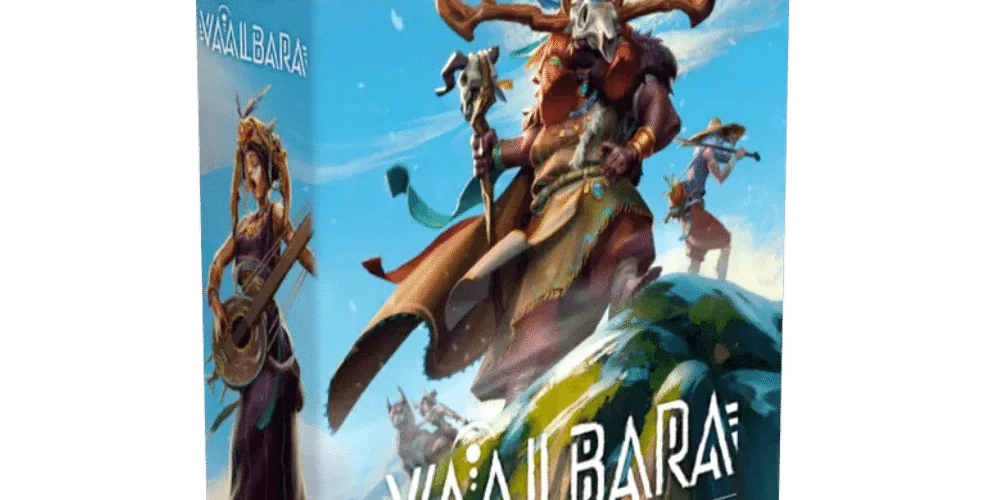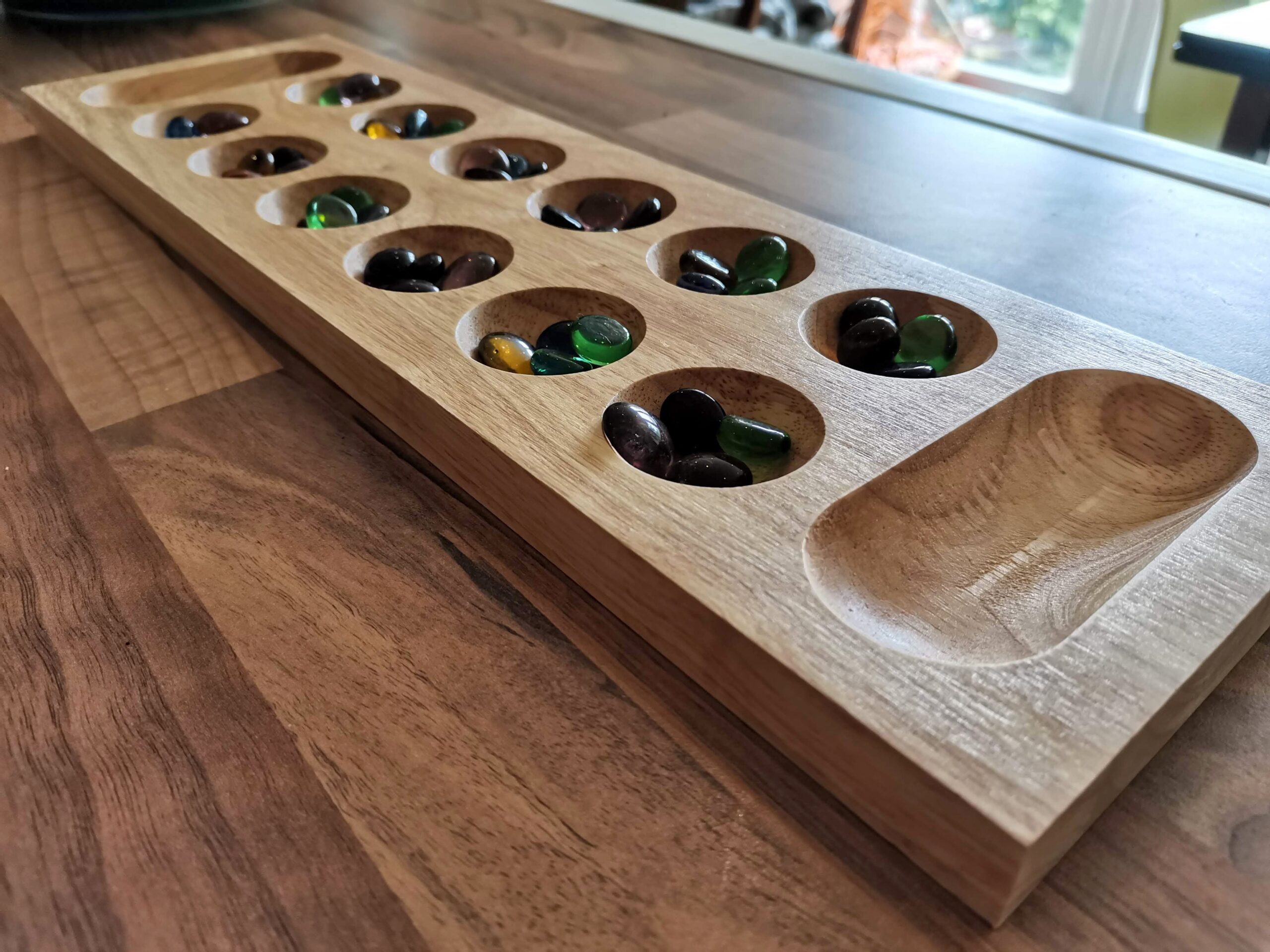Vaalbara Review

You’ll hear Vaalbara described as being “a bit like Citadels” with some Libertalia thrown in (I reviewed Libertalia here). I know this to be true because that’s how I describe it to other people. Citadels, if you’ve never played it (you really should) is a card game where each player plays a card with a role on it in an attempt to add cards to your play area, using them to score and win the game. Libertalia does similar, but with tiles instead of cards to collect. Vaalbara shares some of that DNA but does it in a distinctly different way, resulting in a quick, lightweight game with a decent level of interaction, but no real ‘take that’. If that sounds like your sort of thing, read on.
Taking the initiative
The core of Vaalbara is set-collection. In each of the game’s nine rounds, there are enough land cards on offer for each player to take one and add it to their ‘realm’. Realm is a grand way of saying ‘bit of table in front of you’. Different land types score in different ways, as described on your handy-dandy reference cards, so once you’ve chosen what lands you want to collect, it’s just a case of nabbing those ones from the market row. Everyone else is trying to do the same thing though, so how do you decide who gets first dibs?
Roll for initiative!

Except, there’s no dice, and there’s no rolling. Except for maybe rolling your eyes when someone takes something you want. Initiative in Vaalbara is printed in the top-left corner of the character cards. Ah yes, character cards, I’ve not really mentioned those yet. You’ve all got an identical deck of 12 characters, each with its own initiative number and ability. Shuffle them up, take five cards into your hand, and on each turn you all play one face-down, then do the dramatic reveal. The dramatic reveal isn’t really that dramatic. Instead, it’s more like a group of kids in a primary school trying to give the answer to a rudimentary maths question fastest. Eyes flit back and forth across the cards trying to see who gets to go in which order.
“But Adam, with only 12 cards, surely there are ties. How do you break ties?”. I’m glad you asked, hypothetical reader. I really like this bit. Each of the decks of character cards has a different colour (and symbol, colourblind rejoice), and each of the cards in the lands deck has these symbols in a different order. So if you need to break a tie, you look at the top of the lands draw deck, and break ties based on the order of the symbols. I really like it, it’s pretty unique.
Quick & weak, slow & strong
So you’ve played your characters, flipped them over, and done the mental maths to see who goes when. Now you get to do that character’s thing. Each has a different ability, and as you might expect, the later in turn order you go, the more powerful the effect. The Hunter, for instance, goes first – huzzah! But playing them gives you no instant benefit. Instead, anyone else with The Hunter in their hand can reveal it to grab 1VP. Compare that to the Farmer, sitting on the other end of the scale with an initiative of 12. Playing The Farmer doubles the points you get for your land card in this round. Let’s say you’ve already got four Field cards, and snag a fifth. Fields give you 2VP for every field in your realm so that 10VPs is now double to 20. Twenty!! Twenty is lots.

Play early and get bobbins rewards from your character, but get to pick up first from the Lands market, grabbing that juicy mountain card. Play later for big points, but get left with the dregs. Or play somewhere in the middle, where you get some interesting effects to play with, such as being able to swap a card in this round’s row with one in the row behind it (you always see the next round’s Land cards). All of this planning could be for naught though, because you have no idea which cards are in the other players’ hands, let alone which one they’ve played. The only thing you know for sure is which cards have already been played, but good luck keeping track of that.
It’s in that moment, that point where you commit to your character, where the game comes to life and really shines. That breathless five seconds when the cards are revealed, you work out who goes when, and then figure out whether you might get that Land you really wanted. One of the things I really like is the way being neighbours with other players matters. Some Lands (meadows) give you a point per meadow card in your and your neighbours’ realms, whereas some character cards reward you based on whether you went before or after them. It’s a clever way of introducing interaction without the ‘Take that!’ that games like Citadels have.
Final thoughts
It’s easy for me to sit here and tell you whether I think a game is good or not. Quantifying that opinion is more difficult, so let me illustrate just how good a game this is. I took Vaalbara with me to the UK Games Expo this year (you can read my show report here) and taught it to some friends on the first evening. Later in the evening, they were then teaching it to another group, and the same thing happened the following evening. Just before I left on Saturday, in the pile of communal purchases my friends and I created, there were two more copies of Vaalbara.
It’s not the deepest game in the world, but nor is it long or difficult to teach. I’ve taught it to my wife and son, to friends, and to complete strangers, and everyone has had a good time with it. It plays nicely with all player counts from two to five, but I think it’s best at four and five, where the concept of neighbours really matters. With two or three, everyone is your neighbour, and it just shaves a little off the strategy elements that I prefer to be there.
My copy of Citadels still gets played today, 12 years after I bought it. It goes with me in my bag to all kinds of trips and occasions, because I know anyone can and will enjoy it. The same is now true of Vaalbara. I expect the box to get worn and knackered, and the game to get some wear and tear because it’s going to get played a lot. For less than £20, Vaalbara is a great option that deserves to be in your short and/or filler games collection.
Review copy kindly provided by Hachette Boardgames UK. Thoughts and opinions are my own.
You can buy this game from my retail partner, Kienda. Remember to sign-up for your account at kienda.co.uk/punchboard for a 5% discount on your first order of £60 or more.

Vaalbara (2022)
Design: Olivier Cipière
Publisher: Studio H
Art: Félix Donadio, Alexandre Reynaud
Players: 2-5
Playing time: 20 mins













